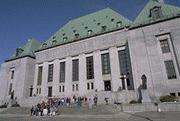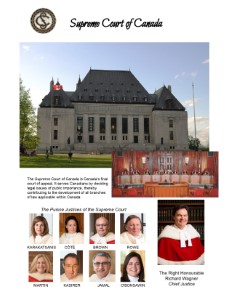Introduction
The Supreme Court consists of the Chief Justice of Canada and eight puisne Justices appointed by the Governor in Council from among superior court judges or from among barristers of at least ten years standing at the Bar of a province or territory. The Chief Justice is sworn as a member of the Privy Council of Canada prior to taking the oath of office as Chief Justice.
No Justice may hold any other remunerative office under the federal or provincial government, nor engage in any business enterprise. The Justices must devote themselves exclusively to their judicial duties. They must reside in the National Capital Region or within 40 kilometres thereof. A Justice holds office during good behaviour, until he or she attains the age of 75 years, but is removable for incapacity or misconduct in office before that time by the Governor General on address of the Senate and House of Commons.
The Supreme Court meets in January, April, and October. Five justices constitute a quorum, but for constitutional cases the justices normally sit as a full court. Under the Supreme Court Act, the court not only pronounces judgement but also advises the federal and provincial governments on important questions of law or fact concerning the interpretation of the Constitution, or the constitutionality or interpretation of federal or provincial legislation, or the powers of Parliament and the provincial legislatures. The most famous and perhaps most important of these opinions is that of September 28, 1981 on the constitutionality of the patriation of the Constitution.

History
Courts of law flourished in eighteenth-century Quebec (Lower Canada) and Ontario (Upper Canada), and in the Maritime colonies during the same period. Judicial records predating 1750 survive in Quebec, New Brunswick and Nova Scotia. The Quebec Act, 1774, section 17, defined powers for creating British-style criminal, civil, and ecclesiastical courts in Quebec, alongside that province's much more ancient French courts. The Constitutional Act, 1791, created the Provinces of Upper and Lower Canada, and established new courts for each province. Next, the Union Act, 1840 created the first Court of Appeal, in this case for Upper Canada, and set salaries for judges in both Canadas.
 It was the British North America Act, 1867, now called the Constitution Act, 1867, that first created a united Canada (Ontario, Quebec, Nova Scotia and New Brunswick) and defined the basic elements of the country's judicial system. The Governor General appoints all county, district and superior court judges. Once appointed, a judge's independence is guaranteed by virtue of his or her serving "during good behaviour". Judicial salaries are "fixed and provided by the Parliament of Canada". Under the British North America Act, all existing provincial courts were to continue and bilingualism was guaranteed in the federal Parliament and courts. At the time of Confederation, decisions from provincial courts could be appealed directly to the Judicial Committee of the Privy Council, in London, for a final decision.
It was the British North America Act, 1867, now called the Constitution Act, 1867, that first created a united Canada (Ontario, Quebec, Nova Scotia and New Brunswick) and defined the basic elements of the country's judicial system. The Governor General appoints all county, district and superior court judges. Once appointed, a judge's independence is guaranteed by virtue of his or her serving "during good behaviour". Judicial salaries are "fixed and provided by the Parliament of Canada". Under the British North America Act, all existing provincial courts were to continue and bilingualism was guaranteed in the federal Parliament and courts. At the time of Confederation, decisions from provincial courts could be appealed directly to the Judicial Committee of the Privy Council, in London, for a final decision.
But the Constitution Act, 1867 invited the new federal Parliament to create its own court of appeal. The Parliament of Canada could "provide for the constitution, maintenance, and organization of a general court of appeal for Canada". This provision was used by Parliament, a few years later, to create the Supreme Court of Canada. However, decisions of the new court could be appealed to the Judicial Committee of the Privy Council in London for final judgment. As the Constitution Act, 1867 made no mention of the direct appeal procedure from provincial courts to the Privy Council, this recourse was left intact. The Judicial Committee's superior appellate jurisdiction over Canada did not end until 1933, for criminal appeals, and 1949, for civil appeals.
SOURCE: Supreme Court of Canada.

|
Click on the picture for free downloads
including this image. |
|


